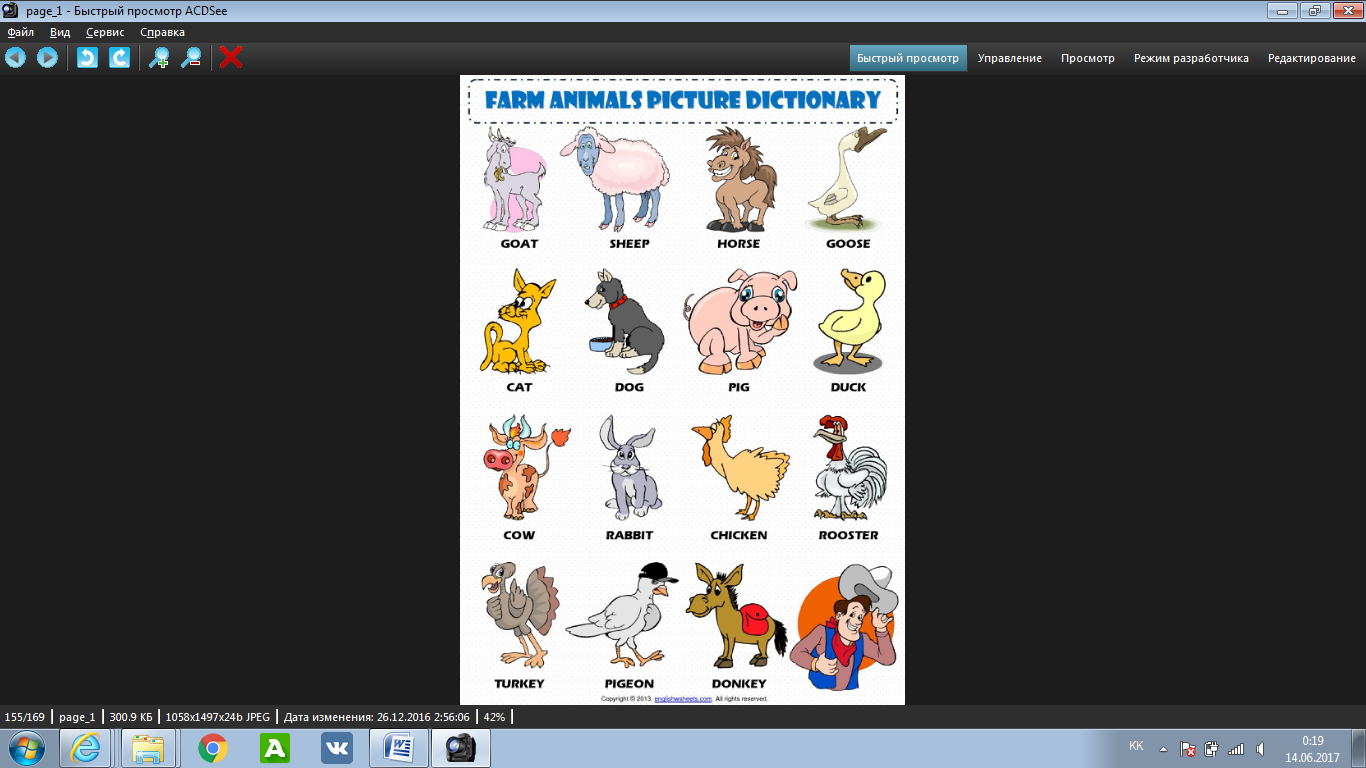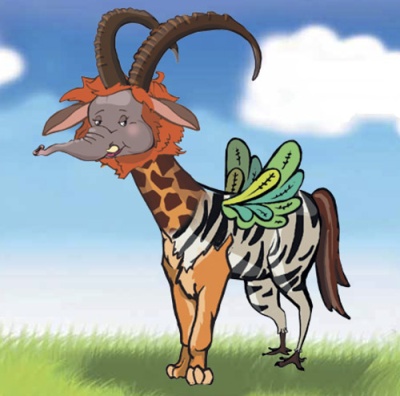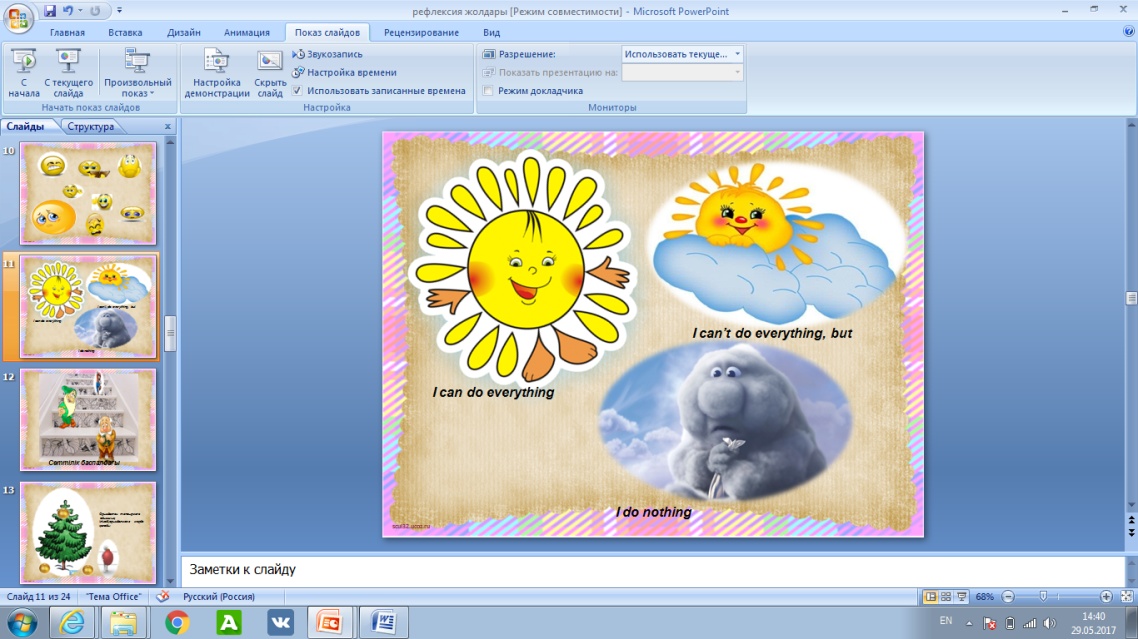
|
Long term plan unit: |
School: Myrzatai secondary school |
||||||||||||||||||||||||||||||||
|
Date:13.10.2017 |
Teacher name: Mailybayeva A |
||||||||||||||||||||||||||||||||
|
Grade: 5 |
Number present: |
Absent: |
|||||||||||||||||||||||||||||||
|
Theme of the lesson:Animals |
|||||||||||||||||||||||||||||||||
|
Learning objectives (s) that this lesson is contributing to |
5.S4 respond with limited flexibility at sentence level to unexpected comments on an increasing range of general and curricular topics 5R2 understand with little support specific information and detail in short, simple texts on a limited range of general and curricular topic 5.W3 write with support factual descriptions at text level which describe people, places and objects 5.UE9 use simple present and simple past regular and irregular forms to describe routines, habits and states on a limited range of familiar general and curricular topics |
||||||||||||||||||||||||||||||||
|
Lesson objectives |
All learners will be able to: -
write with
support factual descriptions at text level which describe animals,
places and objectswith support; -use simple present to describe routines, habits and states ontopic “Animals” with support Most learners will be able to: - write with support
factual descriptions at text level which describe animals, places
and objects with
some
support; -use simple present to describe routines, habits and states ontopic “Animals” with some support Some learners will be able to: - understand specific information and detail in short, simple texts on theme ‘Animals’ without support -write with support factual descriptions at text level which describe animals, places and objects without support; -use simple present to describe routines, habits and states ontopic “Animals” without support |
||||||||||||||||||||||||||||||||
|
Assessment criteria |
- describe specific information and detail in short simple text on given theme; -write with support factual descriptions at text level which describe animals, places and objects ; - make a response on an increasing range of the topic «Animals» -use simple present and simple past regular and irregular forms |
||||||||||||||||||||||||||||||||
|
Value links |
Secular society with high spirituality |
||||||||||||||||||||||||||||||||
|
Cross curricular links |
Biology |
||||||||||||||||||||||||||||||||
|
ICT skills |
pictures of animals |
||||||||||||||||||||||||||||||||
|
Previous learning |
Plants |
||||||||||||||||||||||||||||||||
|
Plan |
|||||||||||||||||||||||||||||||||
|
Time |
Planned activities |
Resources |
|||||||||||||||||||||||||||||||
|
Beginning 10 min |
1. Greeting: duty’s report 2. Psychological atmosphere Phonetic drill You can go to
Africa
3. Checking up the home task talk about sea animals New words: teacher will pronounce every word, students will repeat after teacher domestic animal-үй жануары, wild animal- жабайы жануар, woods- ормандар, ағаштар, jungles-джунгли, fields-жайылым, fox-түлкі, tiger-жолбарыс, wolf-қасқыр, elephant-піл, hare-қоян, horse-жылқы, bull-өгіз, sheep-қой
Descriptors:
|
pictures |
|||||||||||||||||||||||||||||||
|
Middle 25 min |
Speaking4 Method: 5W Questions Ex: 2 Answer the questions Teacher will ask questions then children will answer If some students can’t answer the questions teacher shows them and help with some gestures. Teacher makes discussion around this question: 1. What kind of animals do you know? 2. Where do wild animals live? 3. Where do domestic animals live? 4. When do people use animals? 5. Which animals are very clever? Students try to share their opinions Descriptors; - Answer the questions Method: Imagine Guessing game. Ex: 3. Learners look at the picture and guess, parts of what animals are there on the picture Teacher asks learners: “What animal is it?’’ Learners choose one card and answer.
R.2 Ex:2 Read and translate the text. Differentiation by task for the text: Group 1: underline new words and explain their meanings Group 2: ask 10 questions about the specific details of the text. Group 3: summarize the text. Animals There are two types of animals. We know wild animals. They are those that live in the woods, jungles and in the fields. They are: foxes, tigers, wolves, elephants, hares and so on. And there are animals that live near the people. They are called domestic animals. And some of them even help people. Horses, bulls, dogs help people a lot. Domestic animals are cows, cats, sheep and so on. Many years ago when there were no cars and trucks people used horses and bulls working in the fields. Dogs are our great friends but they also guard our houses and they are used in the army and by the police. Cats catch mice and rats. As for other domestic animals they are also very useful. Hens, ducks, geese, turkeys give meat and eggs. Cows and goats give milk. It should be said that both wild and domestic animals can be good actors and we can see them in the circus. There are animal-trainers that train a certain kind of animals. For example, Kucklachov has the theatre where cats play main parts. Such shows are really funny and interesting. Descriptors; -Read and translate the text UE. 9 Present Simple Tense The simple present tense in English is used to describe an action that is regular, true or normal.
Past Simple Tense The Past Tense is used to talk about something that started and finished at a definite time in the past. Affirmative form
Question form
Negative form
Inductive methods Ex: 1 Make sentences You should make sentences from present and past simple using these verbs Live, help, use, work, play For example: In present: I live in Shymkent. In past: I lived in Moscow Descriptors: - Use of grammar;
W.3 Writing: Ex: 4. Write this exercise in your copybook. PRESENT SIMPLE / PAST SIMPLE 1. I 2. I
3. I
4. Janet
5. Ellie
6. Alex
Descriptors:
|
Student’s book “Oxford” Grade 5, p 48
|
|||||||||||||||||||||||||||||||
|
End 10 min |
My mood after the lesson
|
Smiles Stickers
|
|||||||||||||||||||||||||||||||
|
Additional information |
|||||||||||||||||||||||||||||||||
|
Differentiation – how do you plan to give more support? How do you plan to challenge the more able learners? |
Assessment – how are you planning to check learners’ learning? |
Health and safety check |
|||||||||||||||||||||||||||||||
|
Most support: -they will repeat the new words and they can learn words by repeating -I’ll give them cards which have translation of the words in the text - I’ll show the pictures, if they can’t say it in English, they can say it in their native language Challenge: More able learners: - if they can’t know the name of the picture I’ll tell them the first letter of the word -I will give them unfinished sentences they will continue it.
Teacher gives different activities for each subgroup. Group 1: underline new words and explain their meanings Group 2: ask 10 questions about the specific details of the text. Group 3: summarize the text. |
1. After each activity teacher will assess in oral form (excellent, good, very clever boy or girl, good job ) 2. According to their mood after the lesson students will stick stickers to the smiles that handing on the board 3 Students fill in assessment sheets (put ticks and crosses) |
Safety health technology CD disk Health activities |
|||||||||||||||||||||||||||||||
|
Reflection Were the lesson objectives/learning objectives realistic? Did the learners achieve the LO? If not, why? Did my planned differentiation work well? Did I stick to timings? What changes did I make from my plan and why?
|
|
||||||||||||||||||||||||||||||||
|
Summary evaluation What two things went really well (consider both teaching and learning)?
1:
2: What two things would have improved the lesson (consider both teaching and learning)?
1:
2:
What have I learned from this lesson about the class or achievements/ difficulties of individuals that will inform my next lesson?
|
|||||||||||||||||||||||||||||||||
жүктеу мүмкіндігіне ие боласыз
Бұл материал сайт қолданушысы жариялаған. Материалдың ішінде жазылған барлық ақпаратқа жауапкершілікті жариялаған қолданушы жауап береді. Ұстаз тілегі тек ақпаратты таратуға қолдау көрсетеді. Егер материал сіздің авторлық құқығыңызды бұзған болса немесе басқа да себептермен сайттан өшіру керек деп ойласаңыз осында жазыңыз
animals
animals
|
Long term plan unit: |
School: Myrzatai secondary school |
||||||||||||||||||||||||||||||||
|
Date:13.10.2017 |
Teacher name: Mailybayeva A |
||||||||||||||||||||||||||||||||
|
Grade: 5 |
Number present: |
Absent: |
|||||||||||||||||||||||||||||||
|
Theme of the lesson:Animals |
|||||||||||||||||||||||||||||||||
|
Learning objectives (s) that this lesson is contributing to |
5.S4 respond with limited flexibility at sentence level to unexpected comments on an increasing range of general and curricular topics 5R2 understand with little support specific information and detail in short, simple texts on a limited range of general and curricular topic 5.W3 write with support factual descriptions at text level which describe people, places and objects 5.UE9 use simple present and simple past regular and irregular forms to describe routines, habits and states on a limited range of familiar general and curricular topics |
||||||||||||||||||||||||||||||||
|
Lesson objectives |
All learners will be able to: -
write with
support factual descriptions at text level which describe animals,
places and objectswith support; -use simple present to describe routines, habits and states ontopic “Animals” with support Most learners will be able to: - write with support
factual descriptions at text level which describe animals, places
and objects with
some
support; -use simple present to describe routines, habits and states ontopic “Animals” with some support Some learners will be able to: - understand specific information and detail in short, simple texts on theme ‘Animals’ without support -write with support factual descriptions at text level which describe animals, places and objects without support; -use simple present to describe routines, habits and states ontopic “Animals” without support |
||||||||||||||||||||||||||||||||
|
Assessment criteria |
- describe specific information and detail in short simple text on given theme; -write with support factual descriptions at text level which describe animals, places and objects ; - make a response on an increasing range of the topic «Animals» -use simple present and simple past regular and irregular forms |
||||||||||||||||||||||||||||||||
|
Value links |
Secular society with high spirituality |
||||||||||||||||||||||||||||||||
|
Cross curricular links |
Biology |
||||||||||||||||||||||||||||||||
|
ICT skills |
pictures of animals |
||||||||||||||||||||||||||||||||
|
Previous learning |
Plants |
||||||||||||||||||||||||||||||||
|
Plan |
|||||||||||||||||||||||||||||||||
|
Time |
Planned activities |
Resources |
|||||||||||||||||||||||||||||||
|
Beginning 10 min |
1. Greeting: duty’s report 2. Psychological atmosphere Phonetic drill You can go to
Africa
3. Checking up the home task talk about sea animals New words: teacher will pronounce every word, students will repeat after teacher domestic animal-үй жануары, wild animal- жабайы жануар, woods- ормандар, ағаштар, jungles-джунгли, fields-жайылым, fox-түлкі, tiger-жолбарыс, wolf-қасқыр, elephant-піл, hare-қоян, horse-жылқы, bull-өгіз, sheep-қой
Descriptors:
|
pictures |
|||||||||||||||||||||||||||||||
|
Middle 25 min |
Speaking4 Method: 5W Questions Ex: 2 Answer the questions Teacher will ask questions then children will answer If some students can’t answer the questions teacher shows them and help with some gestures. Teacher makes discussion around this question: 1. What kind of animals do you know? 2. Where do wild animals live? 3. Where do domestic animals live? 4. When do people use animals? 5. Which animals are very clever? Students try to share their opinions Descriptors; - Answer the questions Method: Imagine Guessing game. Ex: 3. Learners look at the picture and guess, parts of what animals are there on the picture Teacher asks learners: “What animal is it?’’ Learners choose one card and answer.
R.2 Ex:2 Read and translate the text. Differentiation by task for the text: Group 1: underline new words and explain their meanings Group 2: ask 10 questions about the specific details of the text. Group 3: summarize the text. Animals There are two types of animals. We know wild animals. They are those that live in the woods, jungles and in the fields. They are: foxes, tigers, wolves, elephants, hares and so on. And there are animals that live near the people. They are called domestic animals. And some of them even help people. Horses, bulls, dogs help people a lot. Domestic animals are cows, cats, sheep and so on. Many years ago when there were no cars and trucks people used horses and bulls working in the fields. Dogs are our great friends but they also guard our houses and they are used in the army and by the police. Cats catch mice and rats. As for other domestic animals they are also very useful. Hens, ducks, geese, turkeys give meat and eggs. Cows and goats give milk. It should be said that both wild and domestic animals can be good actors and we can see them in the circus. There are animal-trainers that train a certain kind of animals. For example, Kucklachov has the theatre where cats play main parts. Such shows are really funny and interesting. Descriptors; -Read and translate the text UE. 9 Present Simple Tense The simple present tense in English is used to describe an action that is regular, true or normal.
Past Simple Tense The Past Tense is used to talk about something that started and finished at a definite time in the past. Affirmative form
Question form
Negative form
Inductive methods Ex: 1 Make sentences You should make sentences from present and past simple using these verbs Live, help, use, work, play For example: In present: I live in Shymkent. In past: I lived in Moscow Descriptors: - Use of grammar;
W.3 Writing: Ex: 4. Write this exercise in your copybook. PRESENT SIMPLE / PAST SIMPLE 1. I 2. I
3. I
4. Janet
5. Ellie
6. Alex
Descriptors:
|
Student’s book “Oxford” Grade 5, p 48
|
|||||||||||||||||||||||||||||||
|
End 10 min |
My mood after the lesson
|
Smiles Stickers
|
|||||||||||||||||||||||||||||||
|
Additional information |
|||||||||||||||||||||||||||||||||
|
Differentiation – how do you plan to give more support? How do you plan to challenge the more able learners? |
Assessment – how are you planning to check learners’ learning? |
Health and safety check |
|||||||||||||||||||||||||||||||
|
Most support: -they will repeat the new words and they can learn words by repeating -I’ll give them cards which have translation of the words in the text - I’ll show the pictures, if they can’t say it in English, they can say it in their native language Challenge: More able learners: - if they can’t know the name of the picture I’ll tell them the first letter of the word -I will give them unfinished sentences they will continue it.
Teacher gives different activities for each subgroup. Group 1: underline new words and explain their meanings Group 2: ask 10 questions about the specific details of the text. Group 3: summarize the text. |
1. After each activity teacher will assess in oral form (excellent, good, very clever boy or girl, good job ) 2. According to their mood after the lesson students will stick stickers to the smiles that handing on the board 3 Students fill in assessment sheets (put ticks and crosses) |
Safety health technology CD disk Health activities |
|||||||||||||||||||||||||||||||
|
Reflection Were the lesson objectives/learning objectives realistic? Did the learners achieve the LO? If not, why? Did my planned differentiation work well? Did I stick to timings? What changes did I make from my plan and why?
|
|
||||||||||||||||||||||||||||||||
|
Summary evaluation What two things went really well (consider both teaching and learning)?
1:
2: What two things would have improved the lesson (consider both teaching and learning)?
1:
2:
What have I learned from this lesson about the class or achievements/ difficulties of individuals that will inform my next lesson?
|
|||||||||||||||||||||||||||||||||

шағым қалдыра аласыз




















